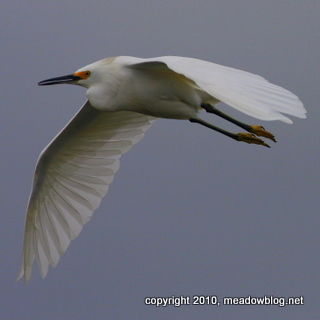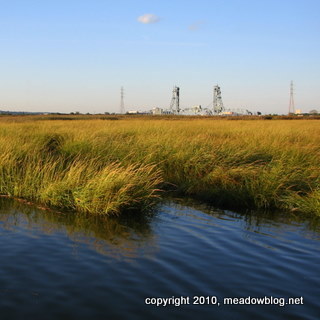
Slowly but surely, the Hackensack River is getting healthier, but there’s more work to be done.
Those are the findings of the first-ever “State of the Hackensack River” review compiled for Earth Day, based on studies by the New Jersey Meadowlands Commission’s scientific arm, the Meadowlands Environmental Research Institute, which has monitored water quality in the river for 16 years.
 MERI has been monitoring the percentages of dissolved oxygen in the Hackensack River each season since 1993, and has found that the water quality of has improved significantly.
MERI has been monitoring the percentages of dissolved oxygen in the Hackensack River each season since 1993, and has found that the water quality of has improved significantly.
Dissolved-oxygen levels – a key to sustaining aquatic life – have increased by 11 percent over that time. MERI now continually takes the river’s pulse through solar-powered water-quality monitoring stations located at four sites along the Hackensack year-round.
 MERI also tracks water turbidity (how cloudy the water is), temperature, salinity and acidity. The extra data provides a fuller picture of the water conditions. High water temperatures, for example, affect dissolved-oxygen levels and can kill fish.
MERI also tracks water turbidity (how cloudy the water is), temperature, salinity and acidity. The extra data provides a fuller picture of the water conditions. High water temperatures, for example, affect dissolved-oxygen levels and can kill fish.
But water quality is just one measure of the river's health. MERI studies have also found a significant improvement in the benthic organisms, or mud-dwelling critters. And a healthier benthic population helped improve the numbers and diversity of fish species in the river.
Fish, in turn, feed birds, and studies by NJ Audubon and others show avian species are returning to the region as well. (Links to the studies below).
The improvements are the result of better sewage treatment, the gradual elimination of combined sewer overflows (which dumped raw sewage into the river after heavy rains), and a reduction in industrial pollution – thanks in large part to the federal Clean Water Act of 1972, regulation and enforcement by the New Jersey Department of Environmental Protection.
The formation of the Meadowlands Commission, which regulates waste disposal and development, also played a major part in the Meadowlands’ — and therefore the Hackensack River’s — recovery.
While changes in government policy have had a major impact on the river’s recovery, the public also played a critical role. And going forward, Meadowlands residents and visitors can continue to help the Hackensack.
According to MERI Director Dr. Francisco Artigas, the main cause of water pollution in the river these days are the excess nutrients reaching the river via runoff from the surrounding urban areas.
These nutrients — nitrogen and phosphorous compounds — come from lawn fertilizers, yard waste and soap from people washing their cars in the driveway. They contribute to the growth of algae and other organic matter.
Known as "eutrophication," this out-of-control algae growth depletes the river's oxygen supply and kills fish and other marine life.
Artigas said that ways to reduce the amount of nutrient run-off include:
• using less fertilizer, phosphorus-free fertilizer or time-release fertilizer
• using low phosphate soaps to wash your car in the driveway
• keeping your sidewalk and yard clean of debris and plant and animal waste
Dumping grass clippings and raked leaves into our waterways can also increase eutrophication, he warned, while dog waste that isn’t disposed of properly washes into storm drains and increases the threat of e coli bacteria in rivers and streams.
For many North Jersey residents, the most visible signs of the river’s recovery are the increasing numbers of birds. Last year, ospreys successfully nested for the first time in recent memory in Kearny, and peregrine falcons successfully nested in the Meadowlands for the first time in recent memory as well – under the Route 3 Bridge. In New Jersey, peregrine falcons are an endangered species and ospreys are a threatened species.
Other birds that feed on fish – from double-crested cormorants to egrets of all sorts – are flocking to the Meadowlands to feed. In late September last year, one birder counted 225 great egrets and snowy egrets in the tidal impoundment next to NJMC Headquarters at DeKorte Park in Lyndhurst.
These observations confirm an earlier study by New Jersey Audubon, which found that avian abundance in the Meadowlands is increasing.
Links to Study Details
The link to a summary of dissolved-oxygen trends is here.
The link to the benthic study is here .
The link to an executive summary of the fish study is here.
To access the current data from any of MERI's water-quality monitoring stations, click here.
A link to the executive summary of NJ Audubon study is here.
The Meadowlands Nature Blog

This sounds like good news!
http://njurbanforest.com/